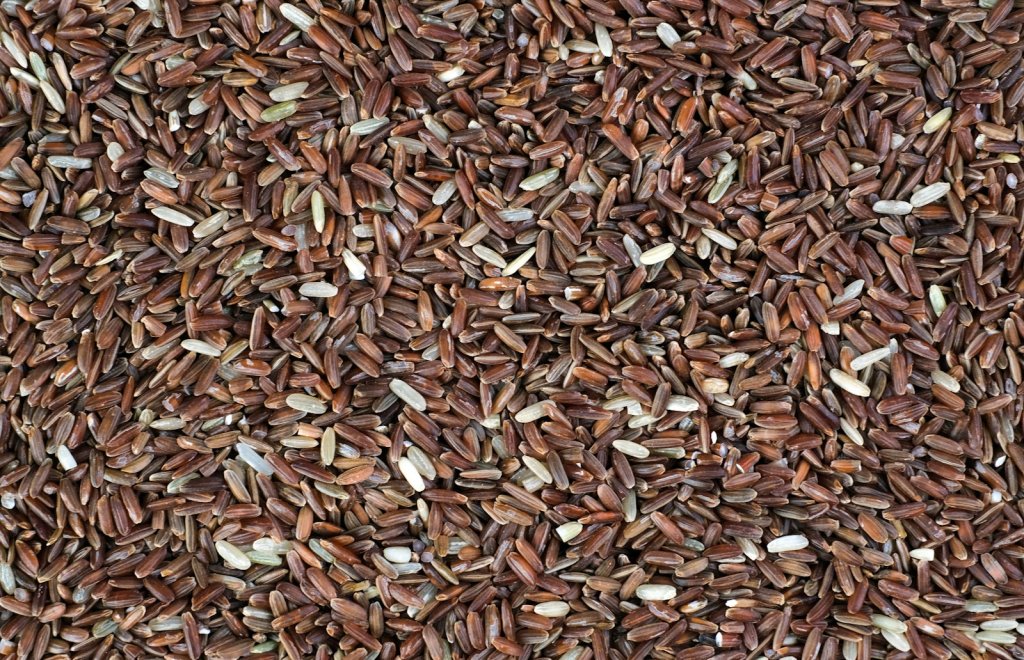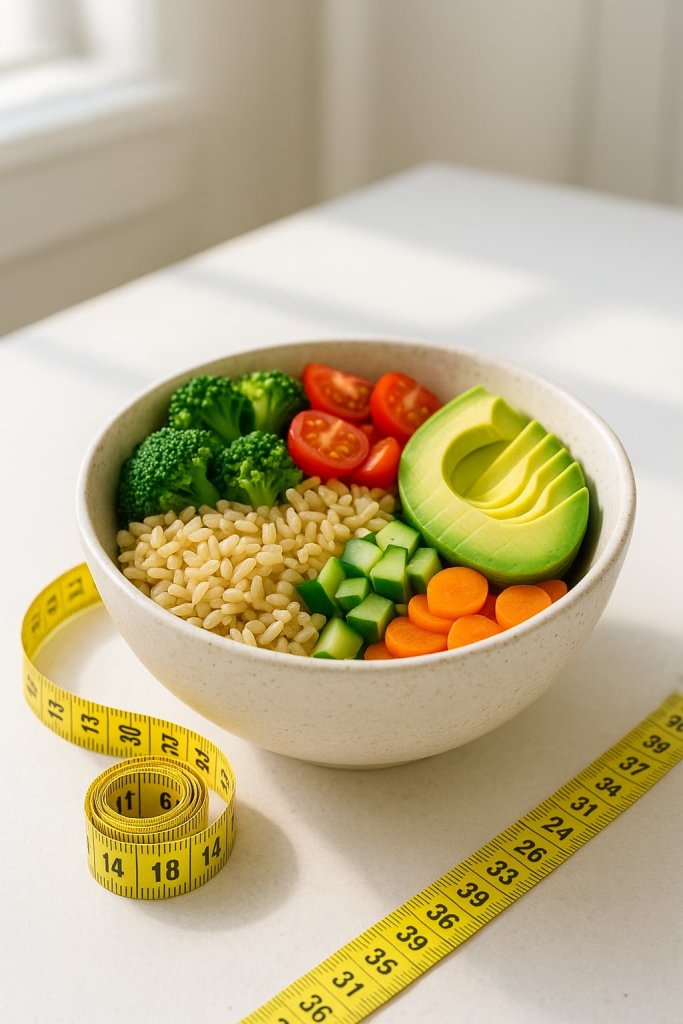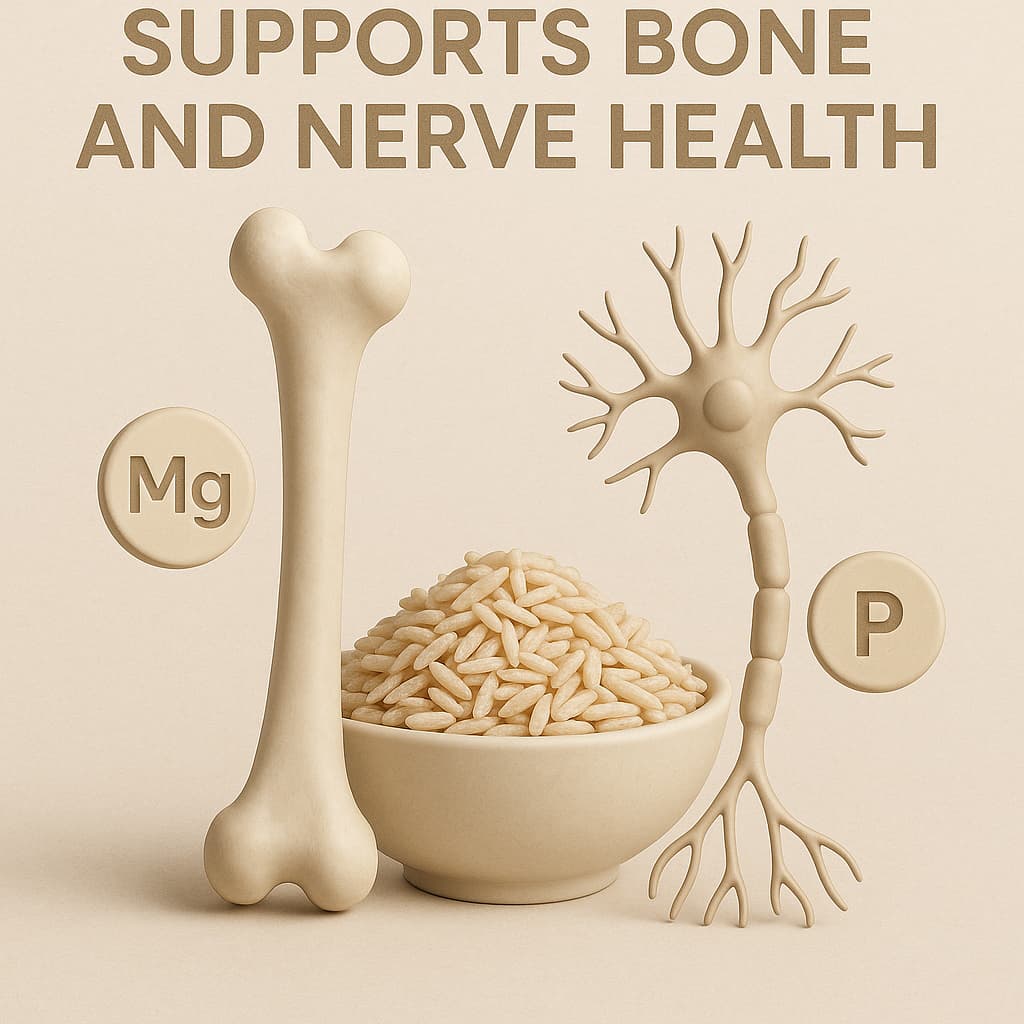Brown rice is a nutrient-rich whole grain that may support heart health, blood sugar balance, and overall wellness.
Unlike white rice, brown rice retains its bran and germ layers—providing more fiber, vitamins, minerals, and antioxidants. Understanding its benefits can help you make smarter dietary choices, especially if you’re seeking long-term health support.
This article explores science-backed health benefits of brown rice, its nutritional profile, possible risks like arsenic exposure, and practical ways to include it in your diet.
(Sources: Harvard Health, WebMD, NIH)
What Is Brown Rice? (Overview and Nutrition Profile)
Brown rice is a whole-grain form of rice that retains its bran and germ layers, making it richer in nutrients, fiber, and antioxidants than white rice.
Unlike white rice—which has the bran and germ removed—brown rice is minimally processed, allowing it to preserve vital nutrients such as magnesium, manganese, selenium, phosphorus, and B vitamins. These nutrients support metabolism, nerve function, and heart health.
Because it is less refined, brown rice digests more slowly and has a lower glycemic index (GI 50–55) than white rice (GI 70–80), meaning it releases glucose more gradually and supports steadier energy levels throughout the day.
This nutritional advantage makes brown rice an excellent foundation for balanced diets focused on long-term wellness and blood sugar stability.

According to the USDA FoodData Central, one cup (195 g) of cooked medium-grain brown rice provides the following key nutrients:
| Nutrient | Amount (per 1 cup cooked, 195 g) | % Daily Value (DV) |
|---|---|---|
| Calories | 218 kcal | — |
| Carbohydrates | 45.8 g | 15% |
| Protein | 4.6 g | 9% |
| Total Fat | 1.6 g | 2% |
| Dietary Fiber | 3.5 g | 13% |
| Magnesium | 83 mg | 20% |
| Manganese | 2.1 mg | 88% |
| Phosphorus | 162 mg | 13% |
| Vitamin B1 (Thiamin) | 0.2 mg | 15% |
| Vitamin B3 (Niacin) | 2.6 mg | 16% |
| Vitamin B6 (Pyridoxine) | 0.3 mg | 20% |
| Selenium | 19 µg | 35% |
(Source: USDA FoodData Central, 2025)
Key Difference from White Rice:
White rice has its bran and germ removed during milling, resulting in significant nutrient loss—especially of fiber, magnesium, and B vitamins. Brown rice, by keeping these intact, provides more complex carbohydrates, plant-based protein, and essential micronutrients that support sustained energy and better metabolic function.
In short, brown rice is not only a staple grain—it’s a nutrient-dense, heart-healthy food that can support balanced diets and long-term wellness when eaten in moderation.
10 Proven Health Benefits of Brown Rice (Backed by Science)
Brown rice is a nutrient-dense whole grain known for its high fiber, vitamins, and mineral content. Scientific studies consistently show that including brown rice in your diet may support cardiovascular, metabolic, and digestive health.
1. Supports Heart Health

Brown rice is a heart-friendly whole grain rich in magnesium, dietary fiber, and plant compounds that may help maintain healthy cholesterol and blood pressure levels.
According to Harvard Health Publishing, the soluble and insoluble fibers in brown rice contribute to lower LDL (“bad”) cholesterol by binding to bile acids and promoting their excretion. This process supports overall lipid balance and cardiovascular health.
Additionally, a large-scale review reported that individuals who regularly consumed whole grains like brown rice had a 22% lower risk of heart disease and 12% lower risk of stroke compared to those consuming refined grains (WebMD, 2024).
2. May Help Regulate Blood Sugar Levels

Because brown rice has a lower glycemic index (GI 50–55) than white rice (GI 70–80), it causes slower glucose absorption and smaller blood sugar spikes.
The Harvard T.H. Chan School of Public Health notes that replacing white rice with brown rice at least twice a week may lower the risk of developing type 2 diabetes by 16–36%.
Its high fiber and magnesium content further support insulin sensitivity, making brown rice a balanced carbohydrate choice for those managing blood sugar.
3. Aids in Weight Management

Brown rice is naturally high in dietary fiber and low in calories, helping promote satiety and reduce overeating.
A study in Frontiers in Nutrition (2023) found that individuals who consumed more whole grains, including brown rice, had significantly lower abdominal fat and healthier BMI levels compared to those who ate refined grains.
By slowing digestion, brown rice supports steady energy release and may help manage weight when combined with a balanced diet and active lifestyle (NIH National Library of Medicine).
4. Promotes Digestive Health

Rich in insoluble fiber, brown rice helps maintain regular bowel movements and supports the growth of beneficial gut bacteria.
According to the National Institutes of Health (NIH), dietary fiber from whole grains aids in waste elimination and may help reduce the risk of constipation and colon disorders over time.
Its natural prebiotic effect also nourishes the gut microbiome, promoting a healthier digestive ecosystem.
5. Rich in Antioxidants and Plant Compounds

Brown rice contains phenolic acids, flavonoids, and γ-oryzanol, powerful plant compounds known for their antioxidant and anti-inflammatory properties.
Research published in the Journal of Agricultural and Food Chemistry (2024) indicates that these antioxidants may help neutralize free radicals and support healthy aging at the cellular level.
These compounds are concentrated in the bran layer of the rice—an element typically removed during white rice processing—making brown rice a more nutrient-preserving choice.
6. Supports Energy and Metabolic Function

Brown rice is naturally rich in B vitamins (B1, B3, and B6), which help convert food into usable energy for the body.
The NIH Office of Dietary Supplements explains that these vitamins are essential for metabolism, red blood cell formation, and nerve function.
Its magnesium content also supports muscle contraction, nerve signaling, and blood sugar regulation, making brown rice an excellent source of sustained energy for daily activities.
7. May Support Gut Microbiome Diversity

The fiber and prebiotic compounds in brown rice promote the growth of beneficial gut microbes such as Bifidobacteria and Lactobacilli.
A 2024 study in the journal Nutrients reported that consuming whole grains like brown rice helps enhance gut microbiota diversity, which is linked to better digestion, stronger immune function, and improved metabolic health (MDPI – Nutrients, 2024).
This prebiotic action supports the gut-brain axis, highlighting the indirect influence of diet on mental and immune well-being.
8. Supports Bone and Nerve Health

Brown rice provides magnesium, manganese, and phosphorus, minerals vital for maintaining bone density and healthy nerve function.
According to the NIH Office of Dietary Supplements, magnesium contributes to over 300 enzymatic processes, including protein synthesis and energy metabolism.
Adequate magnesium intake is associated with a lower risk of osteoporosis, muscle cramps, and nerve dysfunction, particularly in older adults.
9. May Help Lower Cholesterol Levels

The oil extracted from brown rice bran contains γ-oryzanol, a naturally occurring compound that may help reduce LDL cholesterol absorption in the intestines.
According to a 2024 review in Nutrients (MDPI), γ-oryzanol and tocotrienols in brown rice oil show potential in supporting healthy lipid metabolism and reducing oxidative stress in cardiovascular tissues.
This makes brown rice an ideal staple grain for maintaining balanced cholesterol levels as part of a heart-healthy diet.
10. Environmentally and Economically Sustainable
Brown rice production is less resource-intensive because it undergoes minimal processing compared to white rice, retaining more of its natural nutrients.
A 2025 modeling study published in Nutrients (MDPI) estimated that increasing brown rice consumption in the United States could prevent up to 3.4% of new type 2 diabetes cases, potentially saving millions in healthcare costs annually.
Choosing brown rice also supports sustainable agriculture, as whole-grain preservation requires fewer chemical treatments and produces less food waste.
Possible Side Effects and Precautions
While brown rice offers numerous nutritional benefits, it’s important to consume it mindfully due to certain safety and dietary considerations.
1. Arsenic Exposure
Brown rice naturally tends to accumulate more inorganic arsenic than white rice because arsenic—an element found in soil and water—is absorbed and stored in the grain’s bran layer during growth. Since brown rice retains this bran layer, its arsenic content is typically higher than that of refined white rice.
According to the World Health Organization (WHO), long-term exposure to inorganic arsenic may be associated with health risks affecting the skin, cardiovascular system, and nervous system, particularly when consumed in large quantities over time.
The U.S. Food and Drug Administration (FDA) recommends varying grain choices—especially for pregnant women, infants, and young children—to minimize arsenic exposure while maintaining dietary balance. Brown rice can still be safely enjoyed as part of a diverse, whole-grain diet when prepared properly.
Safe cooking practices to reduce arsenic levels:
- Rinse thoroughly: Wash brown rice under running water to remove surface residues.
- Use a 6:1 water-to-rice ratio: Cook rice in excess water and drain the remaining liquid; this method can reduce arsenic levels by up to 60%, according to FDA guidance (FDA – What You Can Do to Limit Exposure to Arsenic).
- Rotate grains: Incorporate other whole grains such as quinoa, barley, millet, or bulgur to ensure variety and minimize risk from any single source.
2. Digestive Sensitivity
Because brown rice is high in fiber, it may cause bloating or gas in individuals with sensitive digestion, irritable bowel syndrome (IBS), or those unaccustomed to high-fiber foods.
Gradually increasing fiber intake and drinking plenty of water can help the body adjust. Cooking the rice until soft and pairing it with cooked vegetables may further improve digestibility.
3. Nutrient Absorption Concerns
Brown rice contains phytates (phytic acid)—natural plant compounds that can bind to minerals like iron, zinc, and calcium, slightly reducing their absorption.
The NIH Office of Dietary Supplements (ODS) notes that this is not a concern for most healthy adults with varied diets. However, soaking brown rice for several hours before cooking helps reduce phytate content and enhances mineral availability.
Key takeaway: Brown rice is safe and beneficial for most people when eaten in moderation and prepared properly.
How to Add Brown Rice to Your Diet

Brown rice can be easily integrated into both traditional and modern meals. Its nutty flavor and chewy texture make it a versatile base for balanced dishes.
Practical meal ideas:
- Grain bowls: Combine cooked brown rice with grilled vegetables, chickpeas, avocado, and a light dressing.
- Stir-fries: Use as a base with tofu, shrimp, or chicken, plus colorful vegetables.
- Soups and stews: Add cooked brown rice to vegetable or lentil soups for added fiber and bulk.
- Breakfast porridge: Simmer brown rice with almond milk and cinnamon for a warm, hearty start.
Cooking tips for nutrient retention:
- Rinse before cooking to remove dust and surface starch.
- Soak for 2–4 hours to reduce cooking time and enhance digestibility.
- Use a 2½:1 water-to-rice ratio for fluffy texture.
- Avoid overcooking to preserve B vitamins and antioxidants.
For balanced meal planning and smart grain swaps, see Harvard Nutrition Source – Rice and Health.
Storage and Food Safety Tips
Proper storage and handling of brown rice are essential to preserve its nutrients and prevent rancidity or bacterial contamination. Because brown rice retains its bran layer, which contains natural oils, it is more prone to spoilage than white rice if not stored correctly.
According to the U.S. Food and Drug Administration (FDA), maintaining clean, dry, and temperature-controlled storage conditions significantly reduces the risk of bacterial growth and foodborne illness. The U.S. Department of Agriculture Food Safety and Inspection Service (USDA FSIS) also emphasizes proper refrigeration and reheating temperatures to keep cooked grains safe for consumption.
For Uncooked Brown Rice
- Store in an airtight container in a cool, dark, and dry pantry for up to 6 months.
- For longer storage, refrigerate or freeze to prevent rancidity caused by the natural oils in the bran layer.
- Avoid exposure to heat, sunlight, or humidity, as these conditions accelerate oil oxidation and attract pantry pests.
For Cooked Brown Rice
- Refrigerate within 2 hours of cooking in a clean, sealed container to prevent bacterial growth.
- Consume refrigerated brown rice within 4–6 days, or freeze for up to 3 months to extend freshness.
- When reheating, ensure the internal temperature reaches 165°F (74°C) — the minimum safe temperature to kill harmful bacteria such as Bacillus cereus.
- Discard rice if it develops an off odor, slimy texture, or mold, as these indicate spoilage.
Frequently Asked Questions (FAQ)
1. Is brown rice good for diabetics?
Yes. Brown rice has a lower glycemic index than white rice, helping to support steadier blood sugar levels when eaten in moderation.
2. Does brown rice contain gluten?
No. Brown rice is naturally gluten-free and suitable for individuals with celiac disease or gluten sensitivity.
3. Can I eat brown rice every day?
You can include brown rice several times per week as part of a varied diet. Rotating with other whole grains helps reduce arsenic exposure and improves nutrient diversity.
4. Is brown rice better than white rice for weight management?
Yes. Its higher fiber and protein content promote fullness, which may support healthy weight maintenance.
5. How long does brown rice last once cooked?
Cooked brown rice lasts 4–6 days in the refrigerator when stored properly in an airtight container.
6. Does brown rice go bad faster than white rice?
Yes. Because it contains oils in the bran layer, brown rice can spoil sooner. Refrigeration or freezing helps extend shelf life.
7. Can children and pregnant women eat brown rice?
Yes — children and pregnant women can eat brown rice in moderation as part of a varied diet. Because brown rice retains its bran layer, it may contain more inorganic arsenic than white rice. The U.S. Food and Drug Administration (FDA) and American College of Obstetricians and Gynecologists (ACOG) recommend rotating grains—such as quinoa, barley, and oats—and using safe cooking methods.
Conclusion
Brown rice is a nutrient-dense whole grain that supports heart health, blood sugar control, and digestive wellness when consumed in moderation.
It provides essential minerals, antioxidants, and fiber that contribute to long-term health. However, mindful preparation—such as rinsing, soaking, and varying your grains—is important to minimize arsenic exposure and enhance nutrient absorption.
Incorporating brown rice as part of a balanced diet can promote sustained energy, improved digestion, and overall metabolic support.
This content is for informational purposes only and not medical advice.
